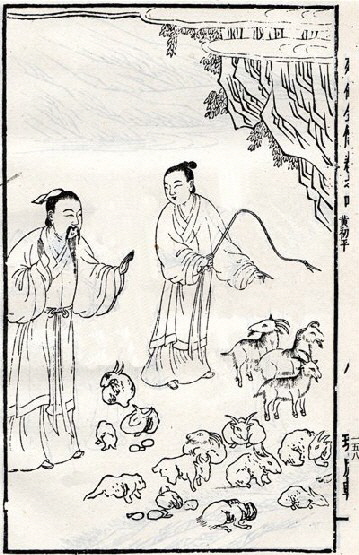|

Huang Chuping swaying his stick of magic over three goats.
ILLUSTRATION. Says Stephen Little, the curator and head of Chinese & Korean Art Department at the Los Angeles County Museum of Art: “Huang Chuping 愽初平 was (is) a Daoist immortal, but not one of the Eight Immortals. A short biography, and the story of his changing goats into rocks (and back) can be found in Wang Shizhen, comp., Liexian quanzhuan 列仙全傳 (The Complete Biographies of the Assorted Immortals) (1598), reprinted in Zhongguo banhua congkan (Compendium of Chinese Woodblock Printing). 4 vols. (Shanghai: Shanghai guji chubanshe, 1988), vol. 3, pp. 143, 158.
|
Says Katherine M. Ball (1859-1952) in her 1927 book Asian Motifs in Asian Art (page 116):

“Another animal of oriental folk-lore, sometimes found among art motives, is the goat. In the Chinese painting by Hsieh Hsi fan, a traditional subject known as San Yuan Ch’en 三羊 (Three Peaceful Goats) is shown. The significance of “peace,” attributed to the goat, is based upon another homophone in which the ideograph for goat and for Yang -- the masculine principle of nature -- have the same sound. Then, as the Yang -- also regarded as the positive principle of good -- is represented by the trigram ☰, so three goats are painted to express a threefold or Great Peace for the whole world.” <Editor’s note: click here for details on the trigrams>
She also mentions Huang Chuping 黄初平(J = Kōshohei), a Daoist immortal, who is associated with the goat. She writes: “This sage when but fifteen years of age conceived the idea of becoming a Sennin, ‘a man of the mountains.” Being a goatherd, he was obliged to take his charges with him; but there he found a cave which afforded him the opportunity for the seclusion he required for meditation. In this, for forty years, he practised austerity and studied the art of magic. His brother, a priest, alarmed at his disappearance, searched for him for many years and finally found him, but without his goats. When questioned regarding them, Huang Chuping raised a stick and struck the stones lying around him on the ground, and instantly they were transformed into goats.”
Says JAANUS: “In paintings the transformation scene is most common, although the brother's presence is often omitted. Well-known paintings include those by Sesshuu 雪舟 (1420-1506; Kyoto National Museum), Kanou Motonobu 狩野元信 (1476-1559; Myoukakuji 妙覚寺, Kyoto) and Maruyama Oukyo 円山応挙 (1733-95; Tooyama Kinenkan 遠山記念館, Saitama prefecture). In ukiyo-e 浮世絵 this subject matter is often used in the year of the sheep for surimono 摺物 (high quality, privately sponsored woodblock prints).”
On the symbolism of the three goats (or sheep) 三羊, see Terese Bartholomew, Hidden Meanings in Chinese Art (San Francisco: Asian Art Museum, 2006), no. 6.16.1, p. 146.
|